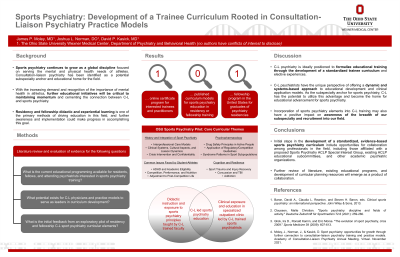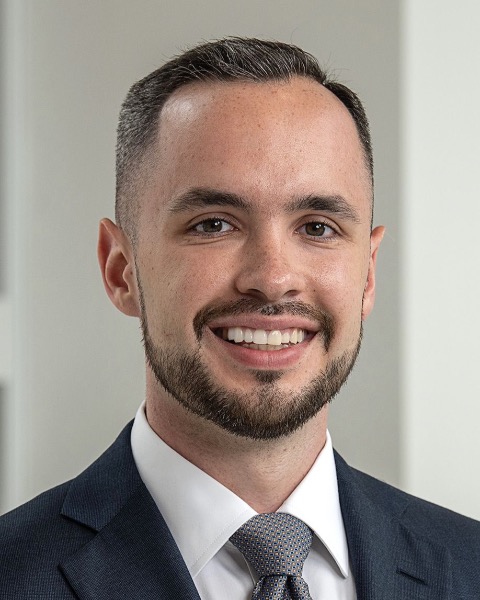Training and Education
Session: Poster Session
(192) Sports Psychiatry: Development of Residency Curriculum Rooted in C-L Psychiatry Practice Models

Trainee Involvement: Yes

James Moley, MD
PGY4 Psychiatry Resident
The Ohio State University Wexner Medical Center
Columbus, Ohio, United States- JN
Joshua L. Norman, D.O.
Clinical Assistant Professor of Psychiatry
The Ohio State University Wexner Medical Center
Columbus, Ohio, United States .jpg)
David Kasick, MD, DFAPA, FACLP
Professor of Clinical Psychiatry and Behavioral Health
The Ohio State University Wexner Medical Center
Columbus, Ohio, United States
Presenting Author(s)
Co-Author(s)
Background/Significance: Sports psychiatry continues to grow as a global discipline focused on serving the mental and physical health needs of athletes. Previous work has established the potential for consultation-liaison psychiatry to serve as a subspecialty anchor and educational home for practitioners who have traditionally lacked central organization. With the increasing demand and recognition of the importance of mental health in athletics, further educational initiatives will be critical to maintaining momentum and cementing the connection between C-L and sports psychiatry. Residency and fellowship didactic and experiential learning is one of the primary methods of driving education in this field, and further awareness and implementation could make progress in accomplishing this goal. Conclusion/Implications: Initial steps in the development of a standardized, evidence-based sports psychiatry curriculum include opportunities for collaboration among professionals in the field, including those affiliated with a proposed Sports Psychiatry ACLP Special Interest Group, existing ACLP educational subcommittees, and other academic psychiatric organizations. Further review of literature, existing educational programs, and development of curricular planning resources will emerge as a product of collaboration. Baron, David A., Claudia L. Reardon, and Steven H. Baron, eds. Clinical sports psychiatry: an international perspective. John Wiley & Sons, 2013. Claussen, Malte Christian. "Sports psychiatry: discipline and fields of activity." Deutsche Zeitschrift für Sportmedizin 72.6 (2021): 259-260. Glick, Ira D., Ronald Kamm, and Eric Morse. "The evolution of sport psychiatry, circa 2009." Sports Medicine 39 (2009): 607-613. Moley, J., Norman, J., & Kasick, D. Sport psychiatry: opportunities for growth through further connection to consultation-liaison psychiatry training and practice models. Academy of Consultation-Liaison Psychiatry Annual Meeting. Virtual. November 2021.
Methods: A literature review of select published English language studies was completed to determine the current educational programming available for residents, fellows, and attending psychiatrists interested in sports psychiatry training. The review also focused on the potential for C-L physicians and practice models to serve as leaders in curriculum development. Additionally, initial feedback from an exploratory pilot of residency and fellowship C-L sport psychiatry curricular elements will be reviewed.
Results: Our review indicated that while some sports psychiatry training is available through one online certificate program and one national fellowship, there is a lack of residency or fellowship curriculum development and evidence-based integration into current academic psychiatric training. Further, C-L educational and practice models are uniquely suited to serve in a facilitating role in the development of formal educational initiatives. Assessment of a curricular pilot reveals benefits of aligning sports psychiatry elements with C-L clinical models and didactic sessions.
Discussion: Given the increasing demand and recognition of the importance of sports psychiatry, C-L psychiatry is ideally positioned to formalize educational training through the development of a standardized trainee curriculum and elective experiences. C-L psychiatrists have the unique perspective of offering a dynamic and systems-based approach to educational development and clinical application models. Incorporation of sports psychiatry elements into C-L training may also have a positive impact on awareness of the breadth of our subspecialty and recruitment into our field.
References:

